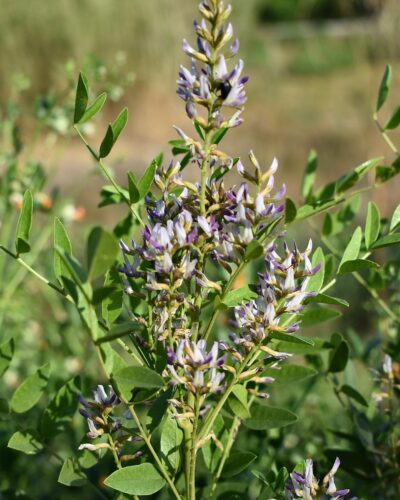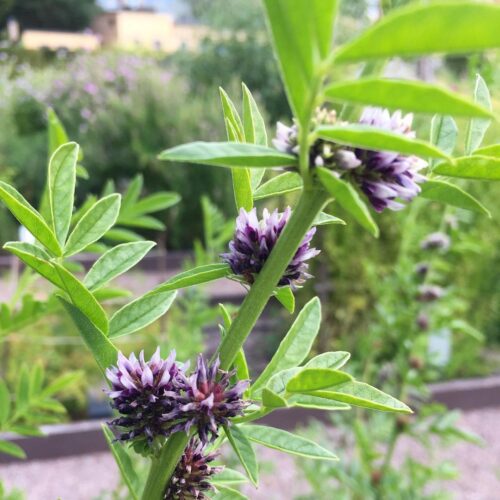Read this Licorice (Mulethi) Care guide for growing this medicinal perennial herb in your garden. It is a great expectorant.
Licorice (Mulethi) has been used for ages as a flavoring agent and an expectorant. You can grow this herb in your home garden with the help of this guide.
USDA Zones— 6 – 11
Other Common Names— Acide Glycyrrhizique, Acide Glycyrrhizinique, Alcacuz, Alcazuz, Bois Doux, Bois Sucré, Can Cao, Gan Cao, Gan Zao, Glabra, Glycyrrhiza, Glycyrrhiza glabra, Glycyrrhiza glabra typica, Glycyrrhiza glabra violacea, Glycyrrhiza glabra glandulifera, Glycyrrhiza Radix, Glycyrrhiza uralensis, Glycyrrhizae, Glycyrrhizic Acid, Glycyrrhizinic Acid, Isoflavone, Jethi-Madh, Liquirizia, Mulathi, Mulethi, Orozuz, Phytoestrogen, Phyto-œstrogène, Kanzo, Lakritze, Liquiritiae Radix, Racine de Réglisse, Racine Douce, Radix Glycyrrhizae, Sweet Root, Yashtimadhu, Yashti-Madhu, Yashti-Madhuka, Zhi Gan Cao, liquorice.
Read: Growing Mint in Water Indoors
Licorice (Mulethi) Information

Native to the Mediterranean and South-West Asia, mainly to the Indian subcontinent where Licorice (Glycyrrhiza glabra) is popular as ‘Mulethi.’ This perennial herb, known as a sweet root, is a legume in reality. It features an extensive system reaching 3 to 4 feet deep, possibly 25 feet in suitable soil. The plant has purple blossoms arranged in a conelike shape. Container planting is possible.
The plant’s roots, known for their sweet anise flavor, hold medicinal properties like anti-inflammatory and expectorant effects. Utilized in Chinese, Ayurvedic, and Greek medicines.
Read: Annatto Achiote Care
How to Propagate Licorice
You can propagate licorice easily through division, cuttings, or seeds.
Growing Licorice from Division
Divide the licorice plant in spring or fall, ensuring each division has one growth bud. If dividing in the fall, replant divisions right away or store them securely for spring planting.
Growing Licorice from Seeds
- Soak seeds in lukewarm water for at least 24 hours.
- Plant them in a seed starting mix made from seed mix recipes.
- Sow seeds at a depth of 1/2 inch covered with soil.
- Keep the soil evenly moist until germination, which takes about two weeks at an optimal temperature of 68°F (20°C).
- Allow 2 feet of space between each plant.
Read: Choy Sum (YU Choy) Growing and Care Tips
When to Plant Licorice
Plant licorice in spring or summer. In warm subtropical or tropical climates, you can grow this herb throughout the year, except during the hottest part of summer.
How to Grow Licorice in Pot
Select a large, upto 8-10 inches, light-colored container, so increased temperature does not affect the roots. Prepare the soil by mixing 1 part of compost, 1 part sand, 1 part loam. If you are growing this herb in cold regions, then keep the pots indoors in the winter months.
How to Grow Licorice on the Ground
Plant Mulethi directly in loose, deep, well-draining soil in an area without stones. Dig a pit measuring 24 inches (60 cm) wide and 20 inches (50 cm) deep, then refill it with the extracted soil. If the soil is clay-rich, add compost and sand to improve its texture.
Read: Growing Parsley from Division
Ideal Growing Conditions for Licorice

Location
Place the shrub in a sunny location for proper growth. If cultivating licorice in the tropics, plant it in an area with afternoon shade.
Soil
Use soil that is light and rich in humus for easy root harvesting and moisture retention. Opt for slightly sandy, well-draining soil with neutral to slightly alkaline pH levels.
Water
Grow this herb with consistent and plentiful watering during the growing season. Maintain slightly moist soil through regular, deep watering. Reduce watering in winter.
Temperature
Licorice plant care is straightforward if you fulfill its basic needs. This herbaceous perennial has mild frost tolerance; it can tolerate temperatures down to 5°F (-15°C).
Read: Growing Celery in Water
Licorice Plant Care

Fertlizer
Licorice does not require fertilizer. However, if the soil is deficient, incorporate compost during planting or use it as mulch around the base of the plant.
Mulch
Apply a layer of mulch to maintain the soil moisture. Make sure it does not touch the stem of the plant.
Pests and Diseases
It typically stays free of pests and diseases. Spider mites may appear on the foliage during dry summers. Prevent them by spraying the foliage with water. Powdery mildew, slugs, and caterpillars can also be problematic.
Harvesting Licorice
Harvest licorice roots two years after planting, typically in fall. Use a sharp spade to extract the horizontal roots. Replant this herb for regrowth, preserving the main roots to avoid damaging the plant.
Storage
When roots become dry, you can store them in a cool, dry area for months. It can also be stored in powdered form in clean, dry jars.
Read: Growing Kohlrabi in Pots
Companion Plants for Licorice
Good Companion Plants for Licorice: Rosemary, Marjoram, and Marigold
Bad Companion plants: Broccoli, Garlic, Onion, Cauliflower, Leek, and Cabbage
Side Effects of Licorice
However, licorice root tea has a caution: it’s not advised for individuals with high blood pressure. If taken on a regular basis, some people have faced a risky reduction in potassium levels and notable hormonal changes. Also, avoid the consumption of this herb in pregnancy.
Read: Companion Plants for Pest Control



